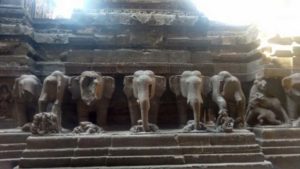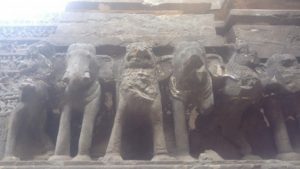A visit to the world heritage site “Ajanta & Ellora caves” at Aurangabad, Maharashtra was truly a beginning for me. A beginning to a search that led to a lot of other interesting findings/thought processes, leaving me more inquisitive than ever.
History
Consisting of 30 rock cut caves, Ajanta was built over a period of 900 years (2 B.C to 6 A.D). Mammoth excavations were turned to fine carvings of exceptional Buddhist sculptures and what the Archaeological Survey of India states “the finest surviving examples of Indian art, particularly painting”. It is believed that Buddhism flourished at the time Ajanta caves were built and hence the caves built during the reign of different Buddhist rulers showcase various stories of the ‘enlightened one’ and selected portions of Jataka tales. The unique paintings on the cave walls, some of which has the modern day “3D” effect, makes one ponder in utter amazement at the vast knowledge of craftsmanship and artistry that their creators possessed thousands of years ago.

Dazzling in its glory on having depicted marvelous sculptures from three different religions viz. the Buddhism, the Hinduism and the Jainism, the Ellora caves too is a spectacular piece of art.

These sculptures also bring forth a lot of facets from the bygone era which are a real treasure and evoke lot of quest around them. For instance, the sculpture that shows Ravana, the king of Srilanka whisking away Sita in the so called “Puskpak Vimana”. Now this ‘pushpak vimana’ looks exactly like the present day ‘jetpack‘ in its features, size, etc. Did Ravana have a jet pack in those times and did he use the same which people back then knew about and we don’t? Well, I was so intrigued by this that I thoroughly searched the net and here’s what I found:
All the dexterously sculpted pieces of art had story in them. Did the artists of these caves know the real stories behind several myths, worn out versions of which are left for us today?
With so many small little pathways within the caves having dead ends and spots of ventilation (big holes on the ground) all across, could there have been an underground habitation also?
This was also something that caught my deep attention.
It’s said that many Muslim rulers including Aurangzeb had sent huge number of soldiers to destroy the sculptures of Ellora caves, trying as hard as they could, they could do little harm to certain structures, unable to make a dent on the rest.
If humans couldn’t destroy even half of what was built, were these structures created by humans at all? If yes, one can only imagine what would have been their built and stamina.
For so many years, Indians as well as foreigners have been exploring the caves in search of answers. Many of them keep coming to these caves repeatedly, each time discovering something new.
For me, I had sneaked out of the ‘maximum city’ with the desire to visit these exceptional creations, to bask in the glory of the past and unravel some historical stories. I did that and much more.
As one stands in awe at one of the ancient hallmarks of artistic excellence, under the clear blue sky of Aurangabad, few questions remain unanswered. Now I know why so many travellers visit this National heritage site multiple times. I wish to go back again soon to find out more.
Following is the line which is perfect for this situation.
“Ruins for me are the beginning. With the debris, you can construct new ideas. They are symbols of a beginning.”
-Anselm Kiefer
The post is written by Puja Roy; she loves to travel to historical sites and write about her experiences and revelations. An avid reader of history herself, she also blogs at speakometer.wordpress.com.